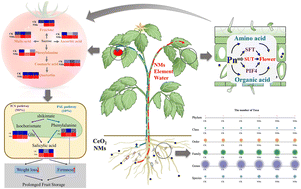Molecular mechanisms of CeO2 nanomaterials improving tomato yield, fruit quality, and postharvest storage performance†
Abstract
Nanomaterials (NMs) have exhibited great potential for improving agriculture production and fruit storage. In the present work, 1, 10, and 50 mg kg−1 of CeO2 NMs were demonstrated to significantly promote tomato yield. Particularly, 10 mg kg−1 CeO2 NMs showed the most significant promotion of tomato yield by 83.7% as compared to the unexposed control along with advanced flowering by 10 days. This increased reproductive growth was mainly due to the accelerated organic acid and amino acid metabolism, more synthesized and transported sucrose, and upregulation of flowering promoter genes. Other than the early flowering and increased production, 10 mg kg−1 CeO2 NMs significantly increased fruit quality (content of malic acid, vitamins and flavonoids) and nutrient elemental content (Na, K, Fe, Cu and Zn). Notably, CeO2 NMs stimulated the synthesis of waxy layers and salicylic acid pathways in fruits, and the picked tomatoes thus showed better storage capacity (greater antibacterial activity, less water loss, and increased hardness) compared to the unexposed control. Finally, the abundance of the postharvest tomato soil microbial community showed a higher mineralization rate and faster soil nutrient cycling. Taken together, CeO2 NMs not only promoted the yield and quality of tomatoes, but also had beneficial effects on postharvest fruit storage and soil quality. The application of CeO2 NMs could be a promising approach for sustainable agriculture.

- This article is part of the themed collection: Environmental Science: Nano Recent HOT Articles


 Please wait while we load your content...
Please wait while we load your content...